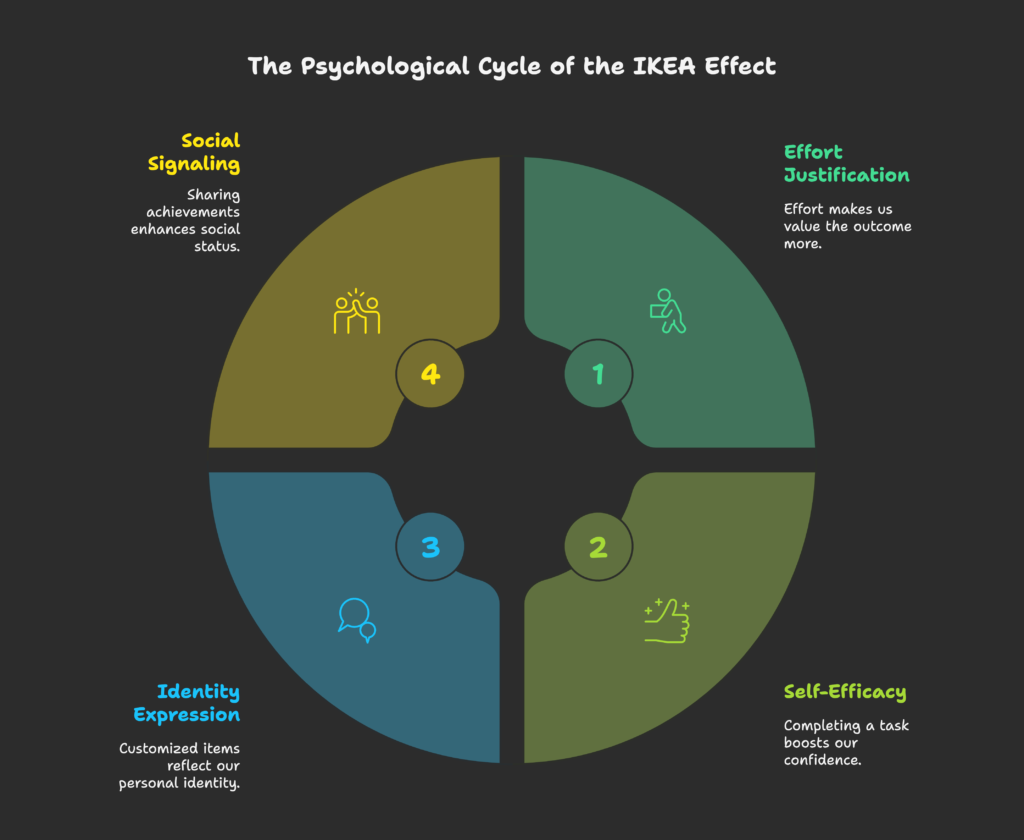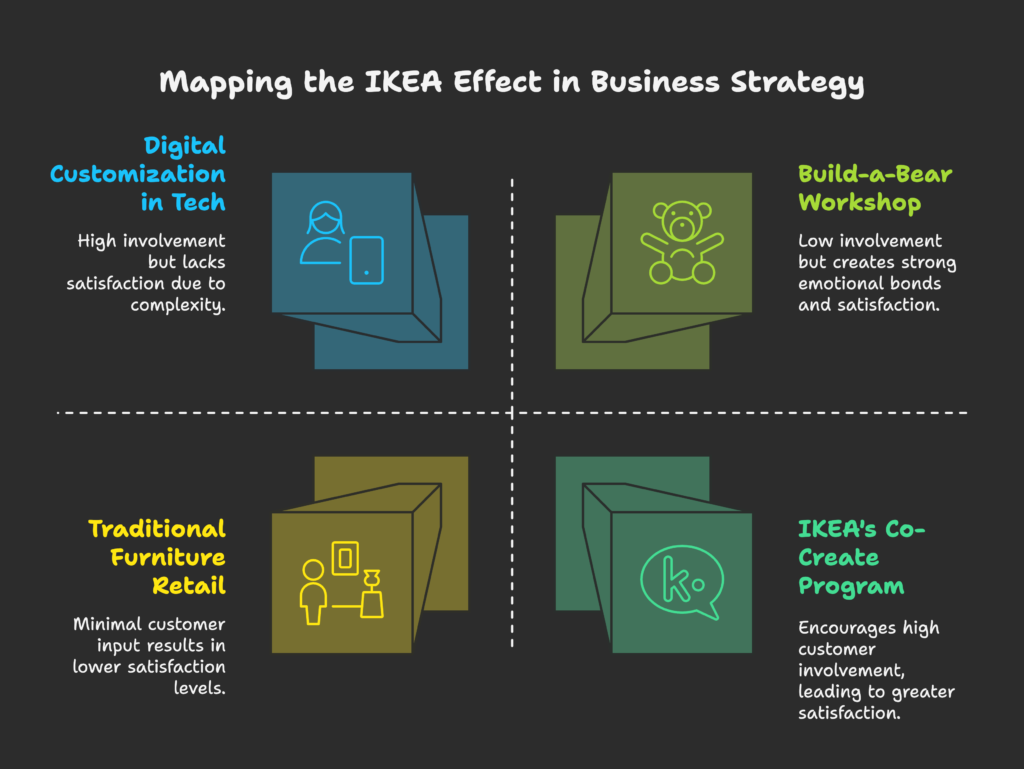Have you ever wondered why building a piece of IKEA furniture makes you feel especially proud of it, even if it’s just a small table? Are you curious about how spending time assembling a product makes you value it more? By reading this article, you’ll discover the fascinating psychological concept behind these feelings—known as the “IKEA Effect”—and learn how businesses use it to create deeper customer satisfaction. Ready to dive in and see how co-creation shapes value perception? Let’s begin!
In this section: We’ll define the IKEA Effect, explore its psychological roots, and understand its business benefits.
Definition and Conceptual Framework
The IKEA Effect is the tendency for people to place higher value on products they help create. This idea builds on older research, such as the mere exposure effect (where familiarity boosts liking). In the 2010s, researchers Norton, Mochon, and Ariely showed that when consumers partially assemble a product, they tend to “fall in love” with it more than if it came pre-made. Real-life examples include furniture assembly, build-your-own meal kits, or even customizing sneakers online.
The Psychological Foundations
Why do we get attached to things we make ourselves? Part of the answer lies in our brains—doing hands-on work can spark neurological activity that fosters a sense of ownership. We also experience cognitive dissonance, meaning we justify our time and labor by telling ourselves the final result is more valuable. Finally, building something ourselves signals competence and boosts our self-esteem.
The Business Value of the IKEA Effect
Businesses that encourage co-creation can save costs (for example, if customers do some of the assembly) while selling products at a higher perceived value. Research suggests consumers may value their creations up to 5 times higher than similar ready-made products. This strategy also gives companies a big advantage over competitors who only offer traditional, fully assembled goods.
We’ve introduced what the IKEA Effect is and why it matters. Next, let’s dig deeper into the psychological mechanisms that make it so powerful!
The Psychological Mechanisms of the IKEA Effect
In this section: We’ll see how effort justification, self-efficacy, identity expression, and social factors combine to intensify our attachment to self-created products.

Effort Justification and Cognitive Dissonance
When we put effort into something, our minds don’t want to believe we wasted our energy. This is called cognitive dissonance reduction. We solve the tension by assuming the outcome is worthwhile. Studies show that the harder we work, the more value we assign to the end result—like a difficult jigsaw puzzle feeling extra satisfying to complete.
Self-Efficacy and Competence
People have a basic need to feel capable. Assembling furniture or baking your own bread can prove to yourself (and others) that you can handle the task. This feeling of competence leads to pride, which then increases your emotional bond with what you created.
Identity and Self-Expression
When you customize or design something, it reflects your individual preferences. The product becomes an extension of your personal identity. That’s why we love unique items we can tailor—these objects resonate with who we are or want to be.
The Social Dimension
Co-created products also let us signal competence to friends and family. For instance, proudly saying “I made this!” can earn praise and status. Shared experiences, like group DIY sessions, build a community feeling around joint creation, making the product even more meaningful.
We’ve broken down the core psychological drivers behind the IKEA Effect. But is there real science backing these ideas? Let’s see what the research says!
Research Evidence Supporting the IKEA Effect
In this section: We’ll review the key experiments that proved the IKEA Effect exists, examine cultural differences, look at neurological findings, and explore factors that influence how strong the effect can be.
Foundational Studies by Norton, Mochon, and Ariely
In one experiment, people were asked to assemble simple IKEA boxes. After building them, they were willing to pay about $0.23 for each box, while those who received pre-assembled boxes valued them at only $0.05. Similar studies with origami found a 5x higher valuation of self-made paper creations. Interestingly, incomplete projects did not have the same effect—completion mattered!
Cross-Cultural Validation Studies
The IKEA Effect appears worldwide. While individualistic cultures (like the U.S.) emphasize personal achievement, collectivist cultures (like many in Asia) still show increased valuation when people participate in creation. The difference is often in how they express or share the pride of creation, but the core phenomenon holds true.
Neurological Evidence
Brain scans reveal that creating something activates reward centers, releasing dopamine. Areas like the nucleus accumbens become more active, increasing our subjective feeling of value. This aligns with the idea that doing and finishing a project produces a rewarding emotional payoff.
Factors Moderating the IKEA Effect
- Task Difficulty: Too hard or too easy can weaken the effect.
- Individual DIY Attitude: Some people love building things more than others.
- Expertise: Skilled builders might have different experiences than beginners.
- Emotional State: If assembly causes stress, the effect might be lower.
Research proves the IKEA Effect is real. Next, let’s see how IKEA itself and other industries harness this power in their business models!
The IKEA Effect in Business Strategy
In this section: We’ll explore how IKEA specifically uses this phenomenon, look at other industries that use co-creation, and discover how digital platforms are extending the effect online.

IKEA’s Implementation Model
IKEA’s flat-pack, self-assembly design is intentional. By making people take part in the final stage of production, IKEA keeps costs down and allows customers to feel proud of their hard work. Assembly instructions are detailed yet achievable, balancing complexity with a sense of accomplishment. Many customers even report enjoying the process, leading to higher satisfaction.
Beyond Furniture: Industry Applications
While furniture is the classic example, other sectors use the IKEA Effect too. Build-a-Bear Workshop lets children pick and stuff their own plush toys, fostering emotional bonds. Meal kits like HelloFresh allow people to cook with pre-portioned ingredients, encouraging them to enjoy their culinary achievements. Tech companies sometimes offer customizable computers or gadgets, letting users configure hardware and software to their liking.
Digital Co-Creation Platforms
IKEA’s “Co-Create IKEA” program invites customers to contribute ideas for new designs. In a broader sense, brands gather feedback and suggestions through online forums or social media. These platforms turn customers into creative partners, fueling innovation and boosting the sense of shared ownership. Metrics often show higher loyalty and more frequent repeat purchases among co-creators.
We’ve seen diverse ways businesses implement the IKEA Effect. Now, let’s unpack the different methods of co-creation and how they each deliver value!
Value Co-Creation Mechanisms
In this section: We’ll look at various types of co-creation, outline the value chain from ideation to execution, and explore how to craft a perfect co-creation experience for your customers.
Types of Customer Involvement
- Assembly-Based: Customers physically build or finalize a product (like IKEA furniture).
- Design-Based: Customizing colors, features, or configurations (like custom sneakers).
- Feedback-Based: Providing ideas, reviews, and suggestions to improve products.
- Community-Based: Working in groups or forums to shape product direction.
The Co-Creation Value Chain
Co-creation starts with ideation (where customers share ideas), then moves to execution (building or customizing). This process benefits businesses through cost savings, brand loyalty, and fresh ideas. Customers gain personalized items, satisfaction, and a sense of pride. Measuring and refining each step ensures both parties keep getting value.
Creating Optimal Co-Creation Experiences
Balance is key: tasks must be challenging enough to feel rewarding, but not so hard that people fail or give up. Clear instructions and good tools help people succeed. Celebrating customers’ achievements—like sharing their creations on social media—also solidifies the emotional rewards.
We’ve explored how co-creation can be structured. Next, let’s look at the practical side: how businesses can implement these concepts in product design, marketing, and more!
Implementing the IKEA Effect in Business Practice
In this section: We’ll dive into product design tactics, marketing approaches, physical and digital environments that support co-creation, and the tools that make it all possible.
Product Design for Co-Creation
- Modular Design: Components that fit together in flexible ways.
- Easy-to-Follow Instructions: Ensuring success for different skill levels.
- Prefabrication vs. Assembly: Balancing how much is done by the company vs. the customer.
- Prototyping: User testing to confirm that most people can complete tasks easily.
Marketing Co-Creation Opportunities
Promote the fun of customizing or assembling, and highlight the personal touch customers can achieve. Show real success stories—like a kitchen someone built themselves—and explain how it became a source of pride and conversation. If you nurture an online community, people can share experiences and tips, boosting interest in co-creation.
Physical Spaces for Co-Creation
IKEA sets up showrooms to inspire and instruct. Other brands hold workshops or “creation stations” in their stores, letting people experiment with product assembly or customization. Community maker spaces allow brands to host events where customers collaborate on projects. This builds both social ties and brand loyalty.
Digital Platforms and Tools
- Online Configurators: Websites or apps that let customers pick features and see immediate previews.
- AR/VR Solutions: Visualizing how a completed creation will look in real life.
- Social Sharing Platforms: Encouraging customers to post photos or videos of their projects.
- AI Personalization: Suggesting design options based on user preferences.
Now you know how to bring the IKEA Effect to life. But what’s in it for businesses beyond happy customers? Let’s uncover the benefits!
The Business Benefits of the IKEA Effect
In this section: We’ll see how co-creation boosts profit, strengthens customer relationships, drives innovation, and helps companies stand out in the market.
Financial Impacts
When customers do some of the labor, businesses save on assembly costs. They can also charge a premium for personalized products because people perceive greater value. Meanwhile, made-to-order models can reduce inventory risks, since products aren’t fully built until they’re purchased.
Customer Relationship Enhancement
Actively involving customers creates emotional bonds with the brand. People are more likely to return and recommend a brand if they feel personally connected to its products. Plus, co-created items often have lower return rates because customers are proud of their role in making them.
Innovation and Product Development
Brands get fresh ideas from customers who suggest improvements or new concepts. By watching how people assemble and customize items, companies learn valuable lessons about design flaws or hidden needs. This shortens the time it takes to perfect new products and reduces the risk of market failure.
Competitive Differentiation
Co-creation experiences are harder for competitors to copy quickly. A strong community of enthusiastic makers can give a brand a unique identity, while also making customers feel like insiders. This loyalty can act as a “barrier to exit,” since people might not want to leave a brand they’ve invested effort in.
We’ve explored how businesses benefit. Now let’s switch gears and see what’s in it for the customers themselves!
The Customer Benefits of Co-Creation
In this section: We’ll look at how co-creation satisfies deep psychological needs, offers tailored experiences, heightens perceived value, and helps customers learn new skills.
Psychological Rewards
Building something yourself leads to a sense of pride and accomplishment. People get a boost in self-esteem when they see the final product of their effort. This positive feeling can spill over into other areas of life.
Personalization and Customization
Co-created products can fit unique tastes or specific needs. For instance, a custom desk might have the exact storage compartments you want. This level of personalization is something mass-produced items often cannot match.
Value Perception and Satisfaction
When you invest your time and energy, you tend to believe the result is more valuable. You also understand the product better—knowing how it was built or why certain features exist. This boosts satisfaction and can make the purchase feel more “worth it.”
Skill Development and Learning
Building or designing products teaches new skills. You might learn basic carpentry, cooking techniques, or design principles. This knowledge can be applied in future projects, encouraging ongoing creativity and growth.
Clearly, co-creation is a win for both businesses and customers. But what challenges might arise? Let’s find out!
Challenges and Limitations of the IKEA Effect
In this section: We’ll address common pitfalls, from customer frustration to ethical concerns. We’ll also explore how to overcome these issues and maintain a positive co-creation environment.
Customer Experience Risks
Assembly can become a negative experience if it’s too difficult or time-consuming. Some people lack the time, tools, or skill to succeed, which can lead to frustration or product returns. Additionally, the end quality might vary if assembly isn’t done correctly.
Business Implementation Challenges
- Standardization vs. Customization: Deciding how many options to offer customers.
- Complex Supply Chains: Co-created products may need specialized parts or packaging.
- Training and Support: Customer service teams must handle more technical questions.
Ethical Considerations
Is it fair to make customers do labor that the business could handle? Some critics argue that companies exploit consumer enthusiasm for DIY. Transparency about the benefits (like lower costs or personalization) is crucial. Also, ensure co-creation is accessible to people of different skill levels and abilities.
Overcoming the Limitations
Brands can provide helpful instructions and videos, or even offer partial pre-assembly. If tasks are balanced and support is readily available, most customers will find co-creation enjoyable. Having alternatives (like full assembly for those who don’t want to DIY) ensures inclusivity.
Now that we know the potential pitfalls, let’s look ahead at how the IKEA Effect might evolve and what new frontiers of co-creation are on the horizon!
Future Directions for the IKEA Effect and Co-Creation
In this section: We’ll explore emerging technologies, sustainability trends, global collaboration, and ongoing research that could shape the next generation of co-creation experiences.
Technological Advancements
- AI-Assisted Design: Letting customers tweak product elements with smart suggestions.
- AR/VR Creation: Virtual spaces for prototyping or “test-building” without physical materials.
- 3D Printing: Potential for home manufacturing of product components.
Sustainability and Circular Economy
Co-creation can reduce waste by producing items that people genuinely love and keep longer. Customers may also help with repair or refurbishment of products, extending their life cycle. Some brands even invite customers to co-create new uses for old products.
Global Co-Creation Communities
Online forums and maker networks connect people worldwide who share tips and ideas. Large brands might run global hackathons or design competitions, inviting diverse perspectives. This broadens creativity and offers fresh solutions that local teams might never consider.
Research Frontiers
Scientists continue to study the long-term psychological effects of co-creation on brand loyalty. Neurological studies may reveal deeper insights into how different personality types respond to co-creation. As methods evolve, we’ll gain better tools to measure co-creation’s true impact on customer relationships.
Excited about what’s next? Let’s wrap up with practical recommendations for businesses wanting to harness the IKEA Effect, plus a glimpse of the co-creation future!
Conclusion and Strategic Recommendations
In this section: We’ll summarize key principles for implementing the IKEA Effect, discuss how to form a strong co-creation strategy, and consider the big picture of where value co-creation is headed.
Key Principles for Effective Implementation
- Ensure Successful Completion: Make tasks challenging but doable.
- Align Complexity with Audience: Beginners need simpler steps, experts might enjoy harder tasks.
- Integrate Co-Creation Across the Journey: From product design to after-sales, encourage participation.
- Offer Meaningful Contributions: Customers must feel their input truly matters.
Building a Co-Creation Strategy
Identify which parts of your product or service can involve consumer effort. Start small—maybe just let people choose colors or add-ons. Collect data on how much they enjoy the process and refine accordingly. Over time, you can scale up to more ambitious co-creation models. Don’t forget to train your teams to handle new types of customer questions and feedback.
The Future of Value Co-Creation
As technology enables deeper collaboration and personalization, consumers will expect to play a more active role in shaping their products. Brands that embrace this early will stand out in the experience economy. By giving people meaningful ways to contribute, you nurture emotional bonds that competitors can’t break easily.
Quick Note: If you’re a Shopify merchant looking to boost sales and customer engagement, consider the Growth Suite application. It helps you streamline co-creation projects and keeps your shoppers happily involved in building products they love!
References
- Norton, M. I., Mochon, D., & Ariely, D. (2011). The IKEA Effect: When Labor Leads to Love. Harvard Business Review. Referenced in Bradenkelley.com
- Beyond Philosophy. (2019, October 6). IKEA Effect, Increasing perceived value.
- Psychologs. (2025, February 28). The IKEA Effect: Why We Value What We Create.
- Brandloungeme. (2024, April 24). The IKEA Effect: Building Impactful Brands Through Collaboration.
- Interaction Design Foundation. (2024, December 6). What is the IKEA Effect?
- Harvard University. (2022). Bolstering and Restoring Feelings of Competence via the IKEA Effect.
- Forbes. (2024, June 12). A Psychologist Explains The ‘IKEA Effect’—How Labor Leads To Love.
- Harvard Business School. (2011). The IKEA Effect: When Labor Leads to Love. Referenced in BradenKelley.com.
- Ingka. (2022, May 10). First hub for co-creation of IKEA products and services opens in Poland.
- Harvard University. (n.d). IKEA: Crowdsourcing ideas to co-create a better everyday life.
- Lund University. (n.d). Leveraging brand co-creation in a digital era: An IKEA case study.
- LinkedIn. (2023, December 22). Embrace the IKEA Effect: How to Revolutionize Product Development with Customer Engagement.




